Penwortham Vicar's delight after succeeding in 13-year-battle to make 'most dangerous' churchyard safe
and live on Freeview channel 276
Since the start of the year, large parts of St Mary’s churchyard in Church Avenue, Penwortham, have been fenced off over concerns about nearly 400 headstones.
As well as preventing access to unsafe resting places, the eight-foot barriers have also stopped access to the historic Castle Hill, the former site of a motte and bailey castle dating back to 1086, which placed Penwortham at the administrative heart of Lancashire before the construction of Lancaster Castle.
Advertisement
Hide AdAdvertisement
Hide AdBut now, thanks to the intervention of recently-appointed council leader Paul Foster and years of perseverance by vicar Chris Nelson, South Ribble Borough Council (SRBC) have agreed to take on work to secure the site, which actually fell to their responsibility 20 years ago.
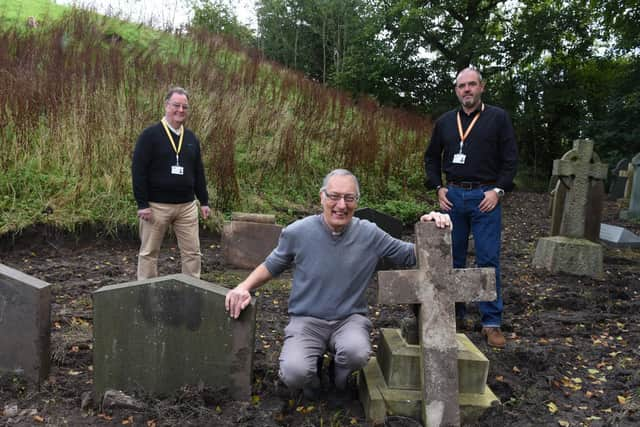

Already more than 30 headstones in the oldest part of the churchyard have been secured, with work on the rest expected to be completed by 2022, though delays have been incurred due to Covid-19.
“It finally feels like someone is listening” said Rev Nelson. “I’m delighted and overjoyed that for the first time since we started having problems in 2007 that I was able to speak with the leader of the council who got it immediately, understood the difficulties, and acted on it.
“It filled me with delight that somebody at the council was taking things seriously and adhering to the statutory responsibilities they have to.”
Advertisement
Hide AdAdvertisement
Hide AdBurials were discontinued in the churchyard in May 2000, save for further burials in existing graves and vaults. At this point, SRBC were served notice, as required by law, that the duty of maintenance of the closed churchyard passed to them.
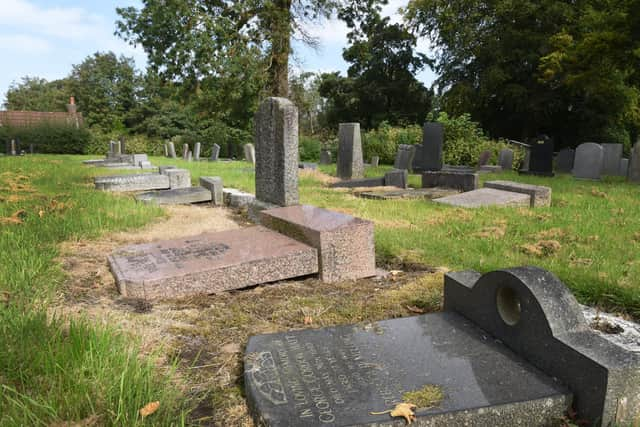

But from 2000 to 2019, Rev Nelson said not one headstone survey was carried out by the council, despite it being an annual requirement, and the only maintenance was grass cutting.
In 2007, Rev Nelson and churchwardens became worried about a number of unstable monuments. SRBC were again reminded of their responsibilities under law, and warning signs were put up in the churchyard, but to the vicar’s growing frustration, no work, other than scheduled grass-cutting was carried out.
In 2012, the council even wrote to Rev Nelson to say they hadn’t got Burial Act documents relating to their responsibility.
Advertisement
Hide AdAdvertisement
Hide AdIn June 2014, a headstone fell on an elderly visitor to the churchyard, fracturing three toe bones, gashing her leg, and causing a three-day stay in hospital.
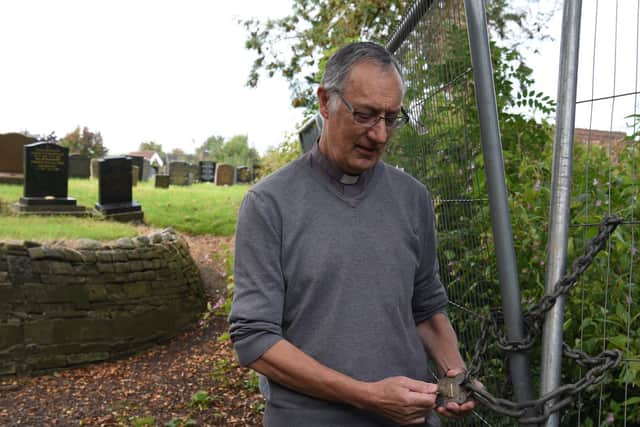

Notices were put up and emergency ‘push’ test commenced, carried out by vicar, churchwardens and congregation. Around 50 headstones deemed unstable were laid flat.
Rev Nelson said: “Having spoken with people in the Diocese, the insurance people, previous council spokespeople, I was very frustrated that they hadn’t got an understanding of the seriousness of it and turned the tables back onto me, when I knew it was a statutory requirement.”
He added: “I had sleepless nights worrying about young children playing in the churchyard and one of them having a stone fall on top of them, and me knowing it should have been sorted and I couldn’t get it rectified, despite contacting everyone I could. Nobody was listening.”
Advertisement
Hide AdAdvertisement
Hide AdIn July 2014 the churchyard was inspected by stone mason Brent Stevenson, who wrote to Rev Nelson stating he was “extremely concerned” about the state of many headstones and recommended the old section be closed off immediately and access pathway from the river side closed.
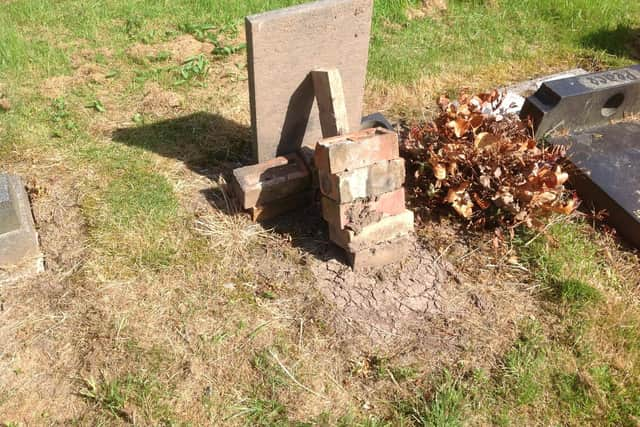

In June 2019, Mr Stevenson again visited again, and in correspondence with the vicar, said he was “very surprised” to see that virtually no safety work had been carried out in five years since his last visit.
In a report, which was sent to SRBC, Mr Stevenson said 137 memorials in the old part of the churchyard were “extremely dangerous” and many could be pushed over by a child with one hand.
He said 246 memorials in the newer section of the churchyard required re-erecting, but these were not as likely to cause death because they are lower ‘lawn type’ memorials.
Advertisement
Hide AdAdvertisement
Hide AdHe also stated: “I have carried out safety inspections in many churchyards and cemeteries in Lancashire, and St Mary’s Penwortham churchyard is by far the most dangerous place. I am not exaggerating by saying that this place is where an accident is waiting to happen”.
Following this report, and with a growing number of complaints from visitors, the Diocean registrar warned SRBC that civil action might be required to force their hand, if no work was done.
In October 2019 a report was carried out by an independent stonemason on behalf of the council, which has been seen by the Post.
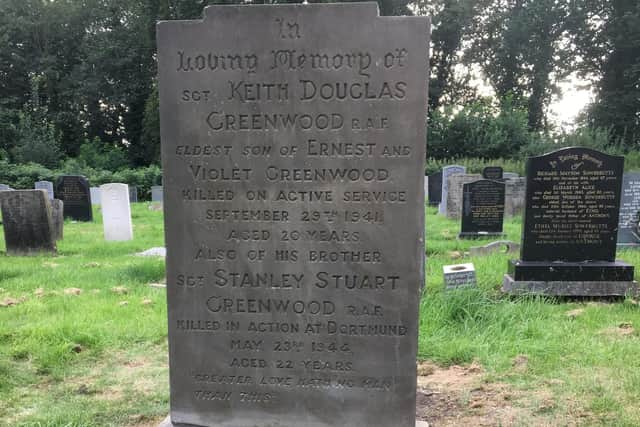

It states: “This (the old section) is so dangerous urgent work is recommended, if this isn’t possible then complete closure of the area should be considered as many of these unstable memorials have the potential to kill or maim”.
Advertisement
Hide AdAdvertisement
Hide AdIt continues: “I have to say that in our 50 years experience of the memorial industry this churchyard has to be the most dangerous that we have seen or inspected, to the point where we felt in danger performing the stability test on the most unstable monuments.”
Knowing there had been a change of administration at SRBC, Rev Nelson rang the new leader, Paul Foster.
Rev Nelson said: “It was only when I contacted the leader of the council directly, that we’ve got anything done. He got it.”
It is believed new a new policy for the maintenance of churchyards in the borough is now being drawn up.
Advertisement
Hide AdAdvertisement
Hide AdAnd as well as work being carried out in the lower churchyard, the council has sent an arborist to inspect the stability of trees.
In 2012 English Heritage requested trees on Castle Hill should be removed because the “nationally important” archaeological remains, the reason for the sites designation as as a scheduled monument, will be broken up over time by tree root growth.
Rev Nelson said the changes pointed to a positive future for St Mary’s which is seeking permission for a new building on the site, for community use.
He said: “This church is rooted in communities of old. But we want to root it also in communities of the future.”
What does South Ribble Council say?
Advertisement
Hide AdAdvertisement
Hide AdCouncillor Sue Jones, cabinet member for environment at South Ribble Borough Council, said the council is committed to its statutory responsibilities.
She said: “It was necessary for the council to take the important step of securing the rear section of the graveyard, as some of the memorials were unsafe and were in danger of toppling over.
“We made this decision to ensure visitors’ safety – and we committed to restoring the area through much needed repair work.
“Unfortunately, due to COVID-19, the contractor that we hired some months ago to deliver the repairs has been unable to commence work at the site because he has been shielding.”
Advertisement
Hide AdAdvertisement
Hide AdDespite this, some work to secure around 30 graves in the lower part of the graveyard, close to Castle Hill, has taken place.
Coun Jones added: “We have no solid completion date for this work, and this is because it is dependent on several factors; however, different sections of the graveyard will start to be reopened as soon as the work in each section is complete.
“We thank visitors for their patience while we undertake these necessary repairs.”
Under the Local Government Act 1972, the duty to maintain a closed churchyard is not conditional on additional funds being available.
What is the law on grave maintenance?
Advertisement
Hide AdAdvertisement
Hide AdThe primary responsibility for the maintenance of graves is with the family as the legal owners.
When family cannot be traced, or when there is no living next iof kin, a secondary liability in respect of public safety arises from the legal responsibility for the maintenance of the churchyard, which falls on the borough council. In St Mary’s case, this responsibility passed to SRBC in September 2000, when the churchyard was closed.
As well as graves, the borough council also has responsibility over maintaining trees, fences, paths and walls.
Anyone wishing to find out more about their family grave, its condition, and what to do next is asked to contact Rev Nelson in the first instance. Do not attempt to rectify any damage yourself.
Advertisement
Hide AdAdvertisement
Hide AdRev Nelson said: “Anyone is able to freely come into the churchyard and the worry is that people will try to re-erect headstones themselves. We have seen instances of this (pictured), and urge people not to.
“Please contact me and we can discuss options.”
Contact Rev Nelson on 07858 772421 or email: [email protected]
What is Castle Hill?
The monument at Penwortham consists of a medieval motte castle strategically situated on a natural mound overlooking an ancient ford across the River Ribble.
It was built shortly after the Norman conquest by Roger of Poitou. It served to guard the estuary of the river and a ford crossing it.
Advertisement
Hide AdAdvertisement
Hide AdIt was recorded in the Domesday Book in 1086 as having attached to it: six burgesses, three 'radmen' (riding men), eight villeins and four neatherds (cattle keepers).
When Roger built Lancaster Castle, Penwortham declined in importance.
In the early 13th century Randolph de Blundeville, Earl of Chester and baron of Lancaster, held his courts in the castle, but soon after the castle fell into disrepair.
The motte lies in St Mary's churchyard north east of the church and includes a tree and scrub covered conical earthen mound having diameters of c.36.5m at the base and 7.6m across the summit.
Advertisement
Hide AdAdvertisement
Hide AdTraces of a shallow ditch separating the motte from a bailey on the south west side survive, but the bailey is now indistinct and its site has been disturbed by construction of the church and burials in the churchyard.
Who are some of the significant people buried in the churchyard?
John Horrocks
Born March 27, 1768, and died March 1, 1804.
Horrocks was a cotton manufacturer and MP for Preston. During his 13 years in Preston he amassed a personal fortune of at least £150,000, and set the foundations for the Horrocks/Miller mill owning dynasty that dominated Preston into the mid nineteenth century.
In 1801 Horrocks built "The Lodge" (later called Penwortham Hall) as a residence for himself. The property, which is a Grade II listed building, is today used as a series of private dwellings.
Advertisement
Hide AdAdvertisement
Hide AdThe recently-opened Penwortham Bypass has been named John Horrocks Way in his honour.
William Rhodes Tuson
The Tuson family, including William Rhodes Tuson, are buried to the rear of the church.
William Tuson was Preston's Chief Education Officer, and in 1974, the then-town's new tertiary college was named after him. It has since been renamed as Preston's College.
Captain Sir Archibald Frederick Hordern
Chief Constable of Lancashire between 1935-50.
Born on June 15 1889, he was the son of Peter Hordern and Edith Charlotte Fearon.1 He died on April 17, 1950 at age 60, unmarried.
Advertisement
Hide AdAdvertisement
Hide AdEducated at Cheltenham College and later the Royal Military College, Sandhurst, he gained the rank of Captain in the South Staffordshire Regiment.
He fought in the First World War between 1914 and 1919.1 He gained the rank of Captain in the Royal Flying Corps and Royal Air Force.
He was awarded the Air Force Cross (A.F.C) and was awarded the Jubilee Medal in 1935.
He was awarded the Coronation Medal in 1937 and appointed Commander, Order of the British Empire (C.B.E.) in 1942. He was appointed Knight Bachelor in 1946
Advertisement
Hide AdAdvertisement
Hide AdHe became a Liveryman of the Coachmakers' and Coach Harness Makers' Company and was awarded the King's Police Medal (K.P.M.). He was also appointed Officer, Most Venerable Order of the Hospital of St. John of Jerusalem (O.St.J.)
His headstone was re-erected by Lancashire Constabulary.
Greenwood brothers
Three Greenwood brothers, sons of Ernest and Violet Greenwood, who were all killed in active service, are buried together in the churchyard.
Keith Douglas Greenwood, RAF, was killed in active service on September 23, 1941 aged 20.
Stanley Stuart Greenwood, RAF, was killed in action in Dortmund, May 23, 1944 aged 22.
Advertisement
Hide AdAdvertisement
Hide AdLeslie Basil Greenwood, was killed July 1950 aged 25 in the Korean war.
When their headstone was found unstable and had to be laid down, the church decided to pay for it to be re-erected as a mark of respect for the brothers' sacrifices, and commissioned stonemason Brent Stevenson to complete the work. They are still waiting for the bill.
There are a total of 22 war dead interred at St Mary's.
Comment Guidelines
National World encourages reader discussion on our stories. User feedback, insights and back-and-forth exchanges add a rich layer of context to reporting. Please review our Community Guidelines before commenting.